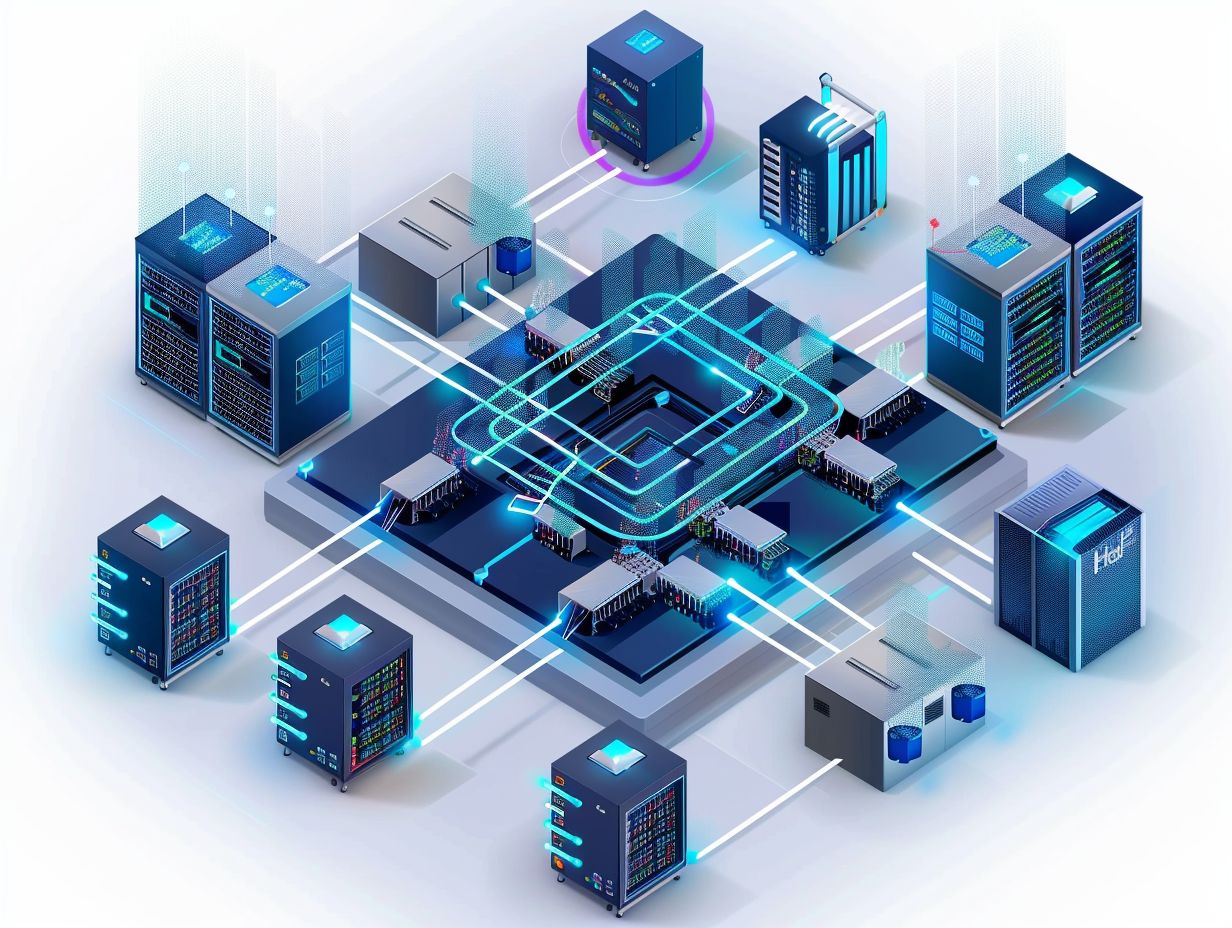In today’s digital age, network virtualization has become a crucial component for organizations looking to enhance their data center capabilities.
This article will explore the benefits of data center network virtualization, specifically focusing on increased efficiency, cost savings, scalability, and flexibility.
A detailed examination of Cisco’s Data Center Storage Area Network (SAN) Fundamentals will be presented, outlining their solutions and strategies.
Furthermore, an in-depth discussion will cover the steps and best practices involved in implementing network virtualization. Common challenges, such as addressing security concerns and managing network complexity, will also be addressed with appropriate solutions.
Please join us as we uncover the fundamentals of Cisco Data Center Network Virtualization.
Key Takeaways:

Defining Network Virtualization
Network virtualization refers to the process of combining hardware and software network resources and functionality into a single, software-based administrative entity, enabling the creation of virtual networks that are independent of the underlying physical network infrastructure.
This approach allows you, as a network administrator, to optimize resources, increase efficiency, and enhance security by segmenting traffic and isolating network functions. By leveraging virtualization technologies such as Cisco’s network virtualization platform, organizations can create multiple virtual networks on a single physical network infrastructure, each with its own unique characteristics and policies.
This flexibility not only streamlines network management but also facilitates faster deployment of services and applications without the need for physical infrastructure changes. Ultimately, network virtualization plays a crucial role in modernizing and transforming traditional network architectures to meet the evolving demands of today’s dynamic business environments.
Benefits of Data Center Network Virtualization
Data Center Network Virtualization provides you with a plethora of benefits, including enhanced efficiency, improved scalability, and increased flexibility in the management of network resources within data center settings.
Efficiency and Cost Savings
Efficiency and cost savings become core benefits when you implement data center network virtualization strategies. This allows organizations like yours to optimize resource utilization, reduce operational expenses, and streamline network management processes.
When you employ data center network virtualization, your company can utilize technologies such as Cisco’s networking solutions to establish virtualized network environments that enhance agility and scalability. This approach leads to a more efficient utilization of resources because virtualized networks can dynamically adapt to changing demands, resulting in significant cost savings in the long run. Centralized management within virtualized environments simplifies network operations, enableing your IT teams to respond promptly to challenges and allocate resources more effectively, ultimately enhancing overall efficiency.
Scalability and Flexibility

You can leverage data center network virtualization to benefit from scalability and flexibility. This technology allows you to expand your network infrastructure easily, adapt to changing business requirements, and support new technologies with minimal disruptions.
This feature is particularly advantageous for organizations seeking efficient management of their network resources. By utilizing solutions from leading industry providers such as Cisco’s Data Center Certifications, businesses can enhance their data center operations and streamline network management activities.
Through virtualization, your network can dynamically respond to varying demands, ensuring efficient and effective allocation of resources. This adaptive capability not only enhances performance but also boosts network security and resilience, facilitating better responses to evolving threats and vulnerabilities.
Cisco’s Approach to Data Center Network Virtualization
You can benefit from Cisco’s comprehensive solutions and technologies designed to facilitate data center network virtualization. Cisco leverages its expertise in networking, security, and cloud technologies to deliver scalable and efficient virtualized network environments.
By harnessing Cisco’s deep understanding of networking infrastructure, innovative approaches have been developed to optimize data center operations. Through Cisco’s software-defined networking (SDN) solutions, organizations can streamline network management, enhance agility, and improve overall performance. Cisco’s advanced security measures, including encryption and intrusion detection systems, are crucial in safeguarding virtualized environments against cyber threats. By leveraging cloud technologies, Cisco ensures seamless integration and automation, enableing businesses to adapt to changing demands with flexibility and cost-efficiency.
Overview of Cisco’s Solutions
Your organization can benefit from Cisco’s comprehensive solutions for data center network virtualization, which include a variety of products and services such as Cisco Nexus switches, Cisco MDS storage switches, and software-defined networking (SDN) solutions. These offerings form a holistic approach to constructing agile and scalable network infrastructures.
The Cisco Nexus switches have have been specifically crafted to provide exceptional performance and scalability in today’s data center environments, facilitating seamless connectivity and effective data traffic management. When paired with the Cisco’s CCNP Data Center networking, organizations can establish secure and dependable storage networking, ensuring support for data accessibility and backup requirements.
By leveraging Cisco’s SDN solutions, businesses have the opportunity to automate network configuration and management processes, thereby streamlining operations and bolstering flexibility in responding to evolving demands within network infrastructures.
Implementing Data Center Network Virtualization
The implementation of data center network virtualization involves a strategic approach that includes assessing your current network architecture, designing virtualized network layouts, integrating virtualization technologies such as VMware vSphere, and implementing best practices to ensure a smooth transition and operation.
Your initial step in this process is conducting an assessment to evaluate your existing network infrastructure, pinpoint areas for improvement, and identify virtualization opportunities. Following the assessment, the next phase involves designing the virtualized network layouts based on the requirements and objectives you’ve identified.
Technology integration, particularly with platforms like VMware vSphere, plays a crucial role in this process. These technologies enable the creation of virtual networks and efficient resource utilization. During implementation, it’s essential to adhere to best practices to ensure proper configuration, implement security measures, and establish monitoring mechanisms for optimal performance and scalability.
Steps and Best Practices

When implementing data center network virtualization, you should follow a structured approach that includes various key steps. These steps typically involve planning and assessment, network design, virtualization deployment, testing, and ongoing optimization. Best practices in this process emphasize key aspects such as security, performance monitoring, and scalability to establish an efficient and resilient virtualized network environment.
During the initial planning and assessment phase, it is essential to conduct a thorough evaluation that includes identifying the current network infrastructure, defining virtualization objectives, and assessing the compatibility of existing hardware and software with virtualization technologies. Network design plays a critical role in creating a comprehensive blueprint for the virtualized network architecture, taking into account factors such as traffic patterns, redundancy, and failover mechanisms.
The deployment of virtualization should be carefully managed to minimize disruptions, with meticulous testing conducted to validate the configuration’s effectiveness. Ongoing optimization is a crucial aspect that involves continuously monitoring performance metrics, identifying bottlenecks, and making necessary adjustments to enhance efficiency and improve the overall user experience.
Common Challenges and Solutions
Addressing security concerns and managing network complexity are common challenges encountered in data center network virtualization. To overcome these obstacles, you must implement robust solutions that encompass advanced security measures, network segmentation, and automation to mitigate risks and streamline operations.
Enhancing the overall security posture of the virtualized network environment can be achieved by implementing strict access control policies and encryption protocols. By segmenting networks into different zones and applying security policies based on traffic types, organizations can limit the lateral movement of threats and contain potential breaches. Automating security tasks, such as threat detection and response, can strengthen defense mechanisms and ensure rapid mitigation of any vulnerabilities or anomalies. These proactive measures not only strengthen the network’s resilience but also optimize operational efficiency by reducing manual intervention.
Addressing Security Concerns
Security concerns in data center network virtualization revolve around protecting your virtualized assets, ensuring data privacy, and preventing unauthorized access. This necessitates the implementation of robust security protocols, encryption mechanisms, and continuous monitoring to safeguard the integrity of your network.
Implementing comprehensive security protocols is crucial for fortifying your network against potential threats. Advanced encryption methods, such as AES (Advanced Encryption Standard) or SSL/TLS protocols, can help safeguard sensitive data from unauthorized access. Continuous monitoring and analysis of network traffic patterns can detect anomalies and potential security breaches in real-time, allowing for swift mitigation actions. By adopting a multi-layered security approach that combines encryption, access control, and vigilant monitoring, organizations can enhance the overall security posture of their virtualized data center networks.
Managing Network Complexity
The complexity of network configurations and interactions in data center network virtualization necessitates efficient network management practices, automation tools, and network monitoring solutions to simplify operations, optimize performance, and ensure seamless connectivity across virtualized environments.
Implementing robust network management and automation tools can help streamline the management of virtual networks, ensuring that configurations and policies are applied consistently and efficiently. By incorporating automation into network provisioning and troubleshooting processes, you can reduce manual errors and respond more quickly to networking issues. Utilizing advanced monitoring tools enables real-time visibility into network performance metrics, allowing for proactive identification and resolution of bottlenecks or connectivity issues. Adopting a comprehensive approach that includes performance optimization strategies along with seamless connectivity protocols is crucial for maintaining a high-performing and reliable virtualized data center network.
Frequently Asked Questions

What is Cisco Data Center Network Virtualization Fundamentals?
Cisco Data Center Network Virtualization Fundamentals is a set of principles and technologies designed to create a virtualized network environment in data centers, allowing for increased scalability, flexibility, and efficiency.
What are the benefits of using Cisco Data Center Network Virtualization Fundamentals?
Some of the key benefits of Cisco Data Center Network Virtualization Fundamentals include reduced hardware costs, improved network performance, simplified management, and increased agility in adapting to changing business needs.
How does Cisco Data Center Network Virtualization Fundamentals work?
Cisco Data Center Network Virtualization Fundamentals uses software-defined networking (SDN) to decouple the network control plane from the physical infrastructure, allowing for more efficient management and automation of network resources.
What are the main components of Cisco Data Center Network Virtualization Fundamentals?
The main components of Cisco Data Center Network Virtualization Fundamentals include the Cisco Application Centric Infrastructure (ACI), the Cisco Nexus series switches, and various software and tools for network virtualization and automation.
Can Cisco Data Center Network Virtualization Fundamentals be used for both traditional and cloud-based data centers?
Yes, Cisco Data Center Network Virtualization Fundamentals can be used in both traditional on-premises data centers and in cloud environments, providing a seamless and consistent network experience across both.
What training and certifications are available for Cisco Data Center Network Virtualization Fundamentals?
Cisco offers a range of training and certifications for professionals looking to learn more about Cisco Data Center Network Virtualization Fundamentals, including the Cisco Certified Network Associate (CCNA) and Cisco Certified Network Professional (CCNP) Data Center certifications.
